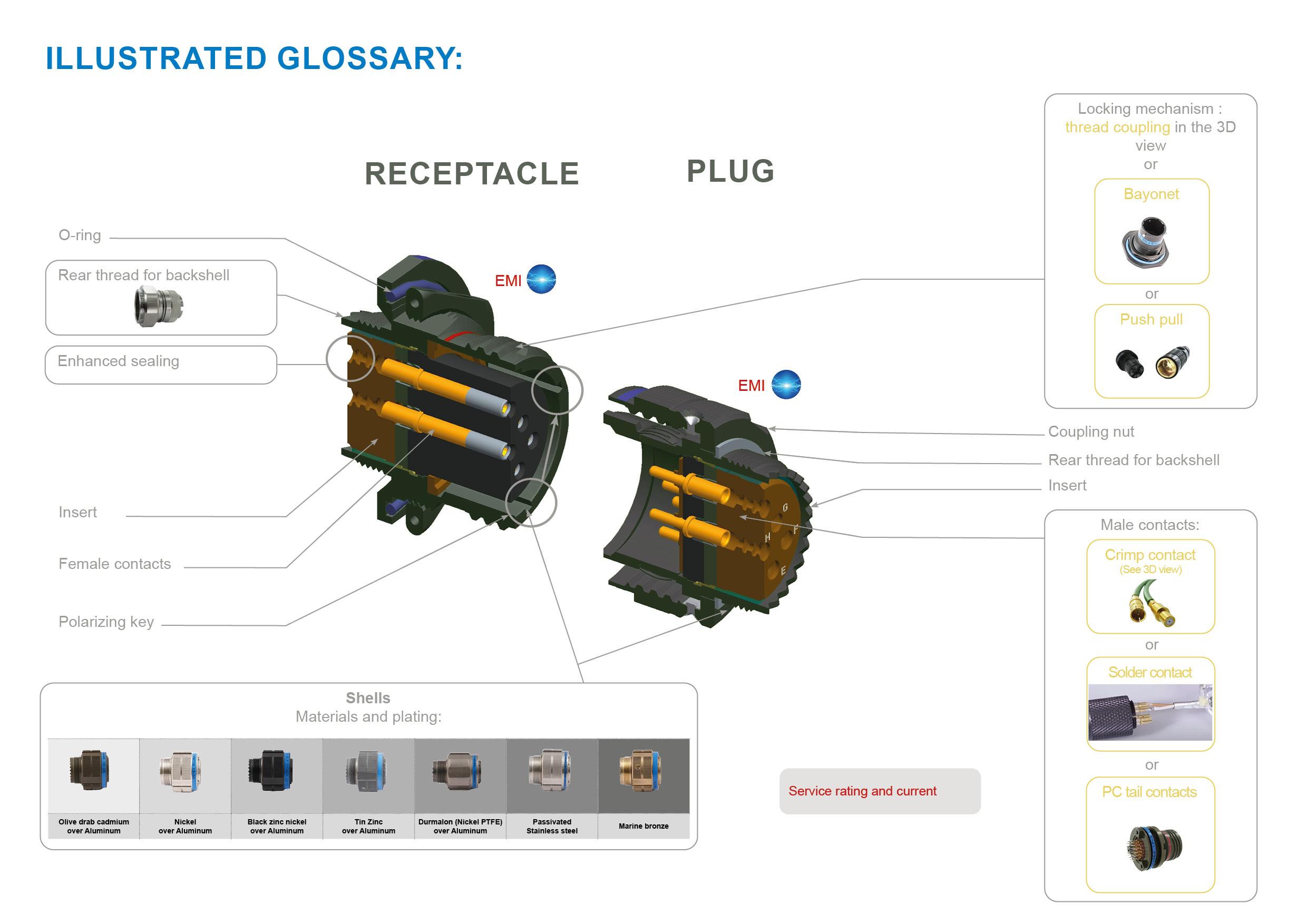Connectivity Glossary
This glossary covers the essential terms for understanding and working with military and aerospace connectors. For more detailed information, contact our technical support.
A
Accessory: Mechanical element added to a connector to improve its functionality, such as cable support or sealing.
B
Backshell: Device screwed onto the rear of the connector to improve the connector's retention, sealing, and/or shielding.
Base / Receptacle: Fixed connector, usually mounted on a panel, which receives the plug.
Bayonet Coupling: A quick-connect mechanism without threads, using ramps to lock the connector.
C
Coaxial Cable: Cable consisting of a central conductor and a shield (foil or braid), used for high-frequency signal transmission.
Contact: Conductive element inside the connector that allows electrical current to pass through.
Coupling or Mating: Method of connecting and locking the two parts of a connector. Different systems exist depending on the application and mechanical or environmental constraints.
Coupling Nut: Threaded or grooved nut on the plug.
Crimp Contact: Type of contact where the conductor is mechanically secured by crimping, without soldering.
D
Disconnect Ring (see Push-pull coupling)
Dust Protection (implied in Enhanced Sealing)
E
Electromagnetic Protection / EMI/RFI Shielding: Methods used to protect electrical signals from electromagnetic interference.
Enhanced Sealing: Connector with an improved design compared to a standard connector to withstand environmental conditions such as moisture and dust.
F
Fiber Optic: Data transmission technology that uses glass or plastic fibers to transmit light.
G
Grommet: A rubber or plastic insulating component that provides a seal around wires entering the connector.
H
Hermetic: A connector designed to be gas- and liquid-tight, often used in vacuum or pressurized environments.
I
Insert or Insulator: Insulating part inside the connector that holds the contacts in place and ensures their alignment.
K
Keying / Polarizing Key: Mechanical device that prevents incorrect connection by ensuring correct alignment of the connectors.
L
Locking Mechanism: System ensuring the secure connection of two mating parts, preventing accidental disconnection.
O
O-ring: Rubber ring used to ensure a tight seal between the connector and the panel.
P
Panel Mount: Method of installing a connector directly onto a panel or enclosure.
PC Tail Contact: Contact designed to be soldered onto a printed circuit board.
Pin Contact: Component of the connector that inserts into the socket contact.
Plug: A movable connector that mates with a receptacle.
Polarizing Key: (see Keying)
Push-pull Coupling: A locking mechanism that engages automatically when the two parts are pushed together and unlocks by pulling on the disconnect ring. Fast and secure, often used in medical, instrumentation, and telecommunications applications.
R
Receptacle (see Base / Receptacle)
S
Service Rating: The maximum voltage that a connector can withstand during normal operation.
Shell: Outer casing of the connector that protects the internal contacts and ensures alignment during mating.
Socket Contact: Component of the connector designed to receive the male contact.
Solder Contact: Contact designed to be connected to the conductor by soldering.
Strain Relief: A type of connector that prevents mechanical forces from damaging electrical connections by relieving tension on the cables.
Surface Treatment or Finish / Plating: Application of a thin layer of metal to contacts or housings to improve conductivity and corrosion resistance.
T
Threaded Coupling: Uses a thread to screw the two parts of the connector together. Provides excellent mechanical retention and high resistance to vibration

